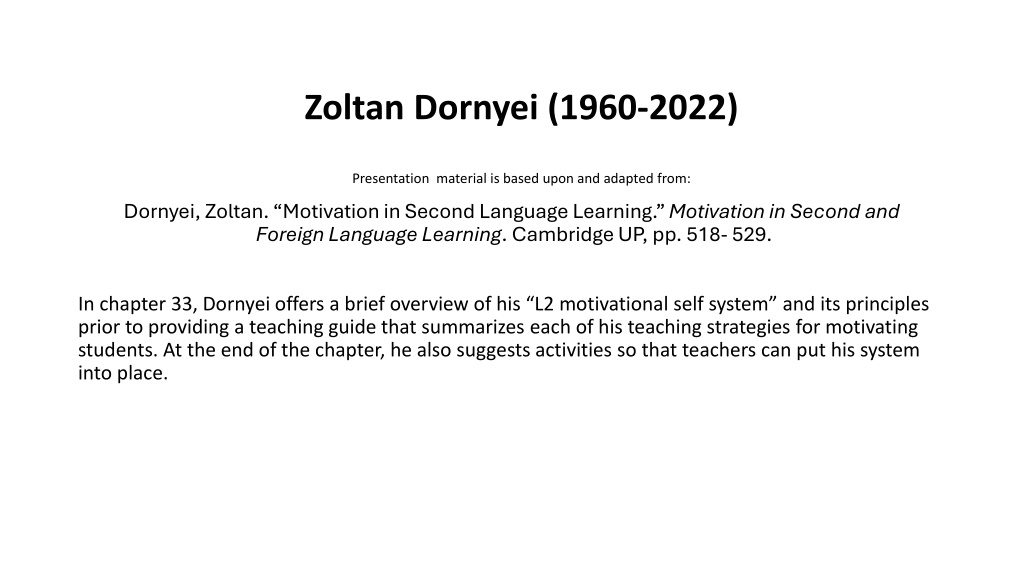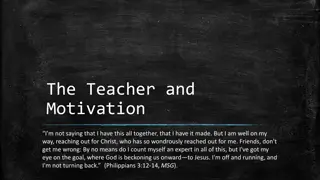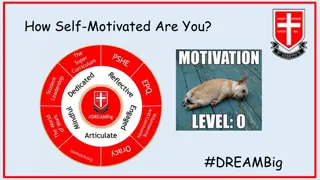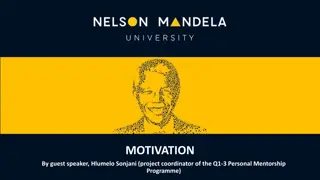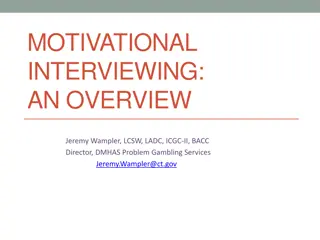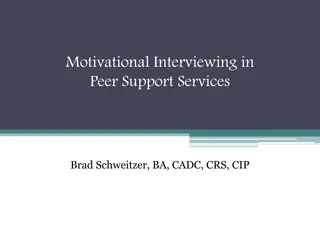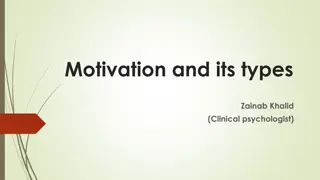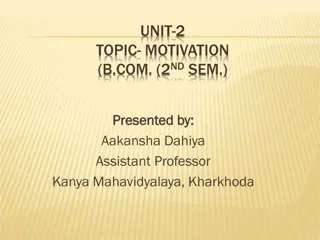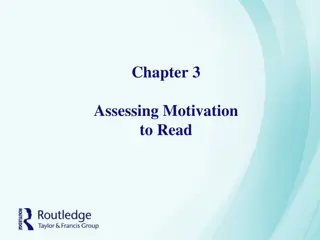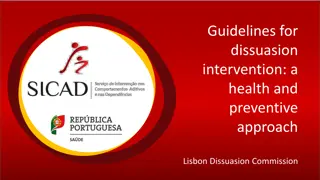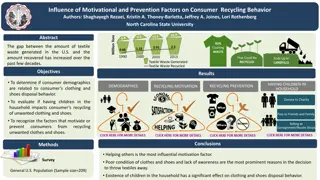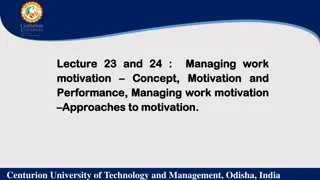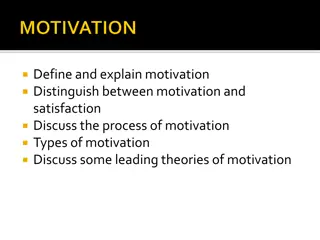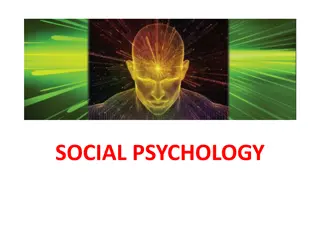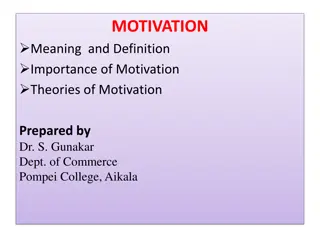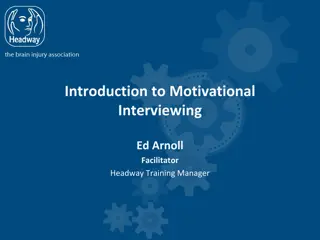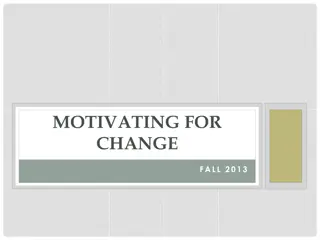Enhancing Language Learning Motivation: Insights from Zoltan Dornyei's L2 Motivational Self System
Zoltan Dornyei's L2 Motivational Self System emphasizes the dynamic interplay of motivation, cognitive, and emotional factors in language learning. By addressing students' ideal self, ought-to self, and learning environment, this approach facilitates creating, generating, maintaining, and encouraging positive self-evaluation for motivation. Classroom applications include strategies focused on learners' future vision, learner experience, and group dynamics to enhance motivation and learning outcomes.
- Language learning
- Motivation strategies
- Zoltan Dornyei
- L2 Motivational Self System
- Educational psychology
Download Presentation

Please find below an Image/Link to download the presentation.
The content on the website is provided AS IS for your information and personal use only. It may not be sold, licensed, or shared on other websites without obtaining consent from the author. Download presentation by click this link. If you encounter any issues during the download, it is possible that the publisher has removed the file from their server.
E N D
Presentation Transcript
Zoltan Dornyei (1960-2022) Presentation material is based upon and adapted from: Dornyei, Zoltan. Motivation in Second Language Learning. Motivation in Second and Foreign Language Learning. Cambridge UP, pp. 518-529. In chapter 33, Dornyei offers a brief overview of his L2 motivational self system and its principles prior to providing a teaching guide that summarizes each of his teaching strategies for motivating students. At the end of the chapter, he also suggests activities so that teachers can put his system into place.
Dornyeis L2 Motivational Self System Dornyei contends that motivation should be viewed through the context of its dynamic interplay with cognitive and emotional factors rather than only through its individual motives in isolation. In his research, he examined motivational conglomerates of motivational, cognitive, and emotional conglomerates of motivational, cognitive, and emotional variables that form coherent patterns or amalgams that act as a whole. His L2 motivational self system combines key aspects of Gardner s 1985 integrative motivation theory (the learners attitude towards a new language and integrating into a community), Noels 2001 adaptation of self determination theory (the learners intrinsic and extrinsic contributing factors) and psychologists Marcus and Nurius s 1986 work on possible selves-- as well as a blend of past research.
Through this lens, Dornyei deduced that a language learners motivation may be stimulated and maintained through a three-pronged approach: What the student wishes to be or his ideal self The students ought-to self The student s learning environment and experiences The Main Components of Dornyei s 2001 Framework Creating the basic motivational conditions Generating Initial motivation Maintaining and protecting motivation Encouraging positive retrospective self-evaluation
CLASSROOM APPLICATION Motivational Strategies Focused on Learners Future Vision Motivational Strategies Focused on the Learner Experience Strategies Focused on Learning Experience: Individual Learner Level Strategies Focused on Group Dynamics
Strategies focused on Learners Future Vision Creating the vision Strengthening the vision Substantiating the vision Operationalizing the vision Keeping the vision alive Counterbalancing the vision (feared self)
If a person has a well established and vivid ideal self--- for example, a person envisions himself or herself as a successful business person- this self-vision can act as a potent future self guide with considerable motivational power (521). Possible selves are more than mere long time goals or future plans in that they involve tangible images and senses; if we have a well developed possible future self, we can imagine this self within vivid and realistic future scenarios (521). Unless motivation is actively maintained and protected, it is likely to decrease in strength over time and even disappear altogether (524).
Strategies Focusing on the Learner Experience: Individual Learner Level Whetting the student s appetite Increasing the learner s expectancy of success Making the teaching material more relevant to the learners Breaking the monotony of learning Making the learning tasks more interesting Increasing the learners self confidence Allowing learners to maintain a positive social image Creating learning autonomy Increasing learner satisfaction Offering grades in a motivational manner.
we need to actively generate positive student attitudes toward L2 learning (524). teachers can help learners to take more satisfaction in their successes and progress (525).
Strategies Focused on Group Dynamics Group cohesiveness Learning about each other Proximity, contact, and interaction Shared group history The rewarding nature of group activities Cooperation toward common goals Investing in the group Group legend Public commitment to the group Investing in the group Extracurricular activities Intergroup competition Defining the group against another Joint hardship and common threat Teacher as role model Group norms
The learner group as a whole has such a powerful influence over members that it can, and often does override the individual students personal preferences. Therefore motivation also needs to be tackled at the group level (527). The two areas of group dynamics that most concern the motivational state of group members are group cohesiveness and group norms (527).
Zoltn Drnyei (1960- 2022) Biography adapted from: The University of Nottingham s website: See In Memorium: Professor Zoltan Dornyei https://www.nottingham.ac.uk/english/news/2021-22/in-memoriam-professor-zolt n-d rnyei.aspx Biography Hungarian born Zoltan Dornyei was a prominent researcher in the field of applied linguistics, a professor of psycholinguistics at Nottingham University s School of English and a theologian. Much of Dornyei s research focused on how motivation affected the language learning process in 2nd language learners, and he has authored numerous books on 2nd language learning, research methods and Christian theology. Research Areas Psycholinguistics and 2nd Language Acquisition, Applied Linguistics and Individual Differences; Motivation in 2nd Language Learners, Research Methods, Group Dynamics, Theology Degrees PhD in Psycholinguistics at E tv s Lor nd University (1989) DSc. in Linguistics from the Hungarian Academy of Sciences (2003) PhD in Theology from Durham University (2017) Teaching Areas: Language acquisition and teaching English as a second language (undergraduate and postgraduate students), teacher training seminars and workshops
Publications: Dornyei has published over 25 books and numerous articles in the fields of psycholinguistics and applied linguistics. His works include: Motivation in Second and Foreign Language Learning (1998) The Psychology of the Language Learner: Individual Differences in Second Language Acquisition (2005) Research Methods in Applied Linguistics: Quantitative, Qualitative, and Mixed Methodologies (2007) Note: This text was praised in the University of Nottingham s Memorium as the key manual in the field. Motivation and 2nd Language Learning (2014) Lessons From Exceptional Language Learners who Have Achieved Nativelike Proficiency Motivation, Cognition, and Identity (2022). His work has also been widely published in journals such as The Tesol Quarterly, Language Learning, British Journal of Educational Psychology, Modern Language Journal, ELT Journal, Journal of Language and Social Behavior, and SAGE Journals. Some of his speeches from teaching conferences on language learning may be viewed on Youtube.
Questions How can we encourage students to visualize a better schema for their ideal selves than the ones they see in advertisements and on social media, especially since both mediums often focus only on the quick fix and the purchase of expensive goods? What if students aspirational ideal selves tear them from their roots? How can we help them to avoid this conflict? Psychologically, what do you believe is the best way to motivate second language learners, so they don t feel estranged from their families and communities? How do you suggest we assess students writing so they re less grade-focused and more likely to want to take responsibility for their own learning? Which of these motivational strategies do you think might be the most helpful for students with ADHD and other learning disabilities or anxiety & depression? Why? Do you believe teachers should counter-balance the students ideal visions by having them imagine the consequences of failing? How might groups define the group against another without destroying a classroom s sense of unity?
